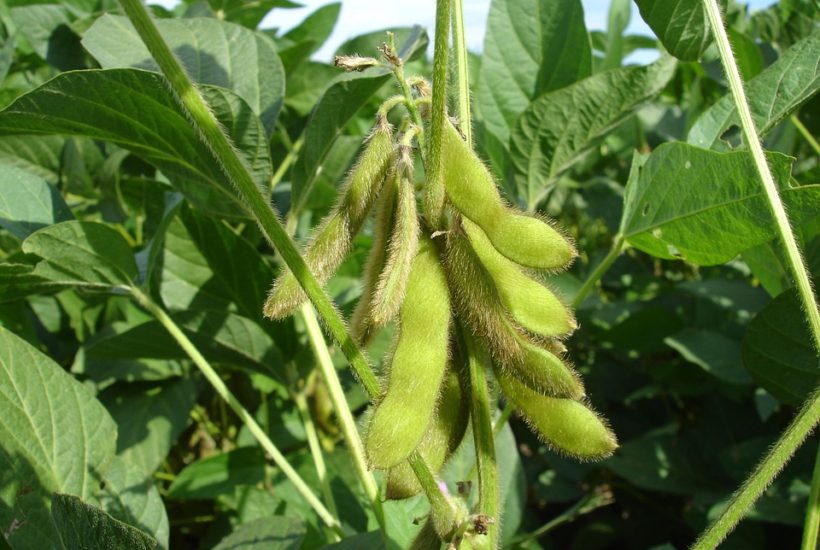Featured
Soybean markets move higher with expected good trade talks
Soybean markets were sharply higher last week as China bought US Soybeans in anticipation of good progress in trade talks that will continue this week. In addition, the USDA quarterly stocks report showed significantly less stocks than the market had expected. USDA overestimated crops last year and recently changed production estimates in response to the final stocks estimates.

Wheat
Wheat markets were mixed last week, with Chicago SRW prices a little higher and Chicago HRW and Minneapolis Spring Wheat prices a little lower. The weakness was mostly in the Minneapolis market last week and came in response to a freeze and snow even that happened in the northern Great Plains and in western Canada in the previous weekend. It was a big storm but did not seem to cause a lot of damage to the remaining Spring Wheat. The Spring Wheat harvest is almost done in the US but there was still enough harvest left that USDA announced it would make another survey for the November report. It estimated the Spring crop at about 600 million bushels but this number will change. The harvest has been very slow in Canada this year as well and it is starting to get cold in the Prairies. It is that time of year!
The Winter Wheat crop is getting planted in the central and southern Great Plains as well and probably also in the Pacific Northwest. Southern Midwest Wheat will be planted soon as the Soybeans harvest is finally getting underway. USDA will issue another monthly supply and demand update on Thursday but few changes in ending stocks levels are anticipated for this month. The Small Grains production report showed Winter Wheat production about as expected and uncertain Spring Wheat and Durum estimates that will be revised next month.
Corn
Corn and Oats both closed higher last week. Futures rallied in response to the USDA quarterly stocks reports that showed less Corn in the country than anticipated. There is still more than 2.0 billion bushels of Corn out there, but the final total was almost 400 million bushels less than anticipated. The report has important ramifications for the coming crop year as well as the September estimate serves as ending stocks for the 2018-19 season and beginning stocks for the 2019-20 marketing year. It means that the potential is there for lower ending stocks than original projections in the supply and demand estimates on Thursday. USDA will also issue a production estimate but probably has no real idea of what is going to be the final production as the harvest is just now getting underway in most of the country.
Yields so far have been good in parts of Iowa and fin a few places east of the Mississippi River, but below historical averages in many areas east of the river. Demand for US Corn has also been disappointing so far this year. The export pace is down to almost half of last year and ethanol demand has been lower than last year. Demand for ethanol will remain weaker due to the waivers granted to 31 refineries by the Trump administration a few weeks ago. The government announced plans to restore a part of this lost demand but the relief will not come right away and will take months if not years to reach down to Corn producers and processors.
Soybeans and Soybean Meal
Soybeans and Soybean Meal were sharply higher as China bought US Soybeans in anticipation of good progress in trade talks that will continue this Thursday and Friday. The market also reacted to the USDA quarterly stocks report that showed significantly less stocks than the market had expected. USDA overestimated both the Corn and Soybeans crops last year and was able to change Soybeans production estimates on Monday in response to the final stocks estimates. Corn estimates can only be changed in January. Traders are waiting now for the next round of production and supply and demand reports that will be released on Thursday.
Harvest activities are only now getting started so the data that USDA will have to work with on production will be less than normal. Initial yield reports have not been real strong so USDA can find less but just how much less is still a big question. USDA will also have to work with the demand side of the ledger as trade problems still need o to be resolved. Demand so far has been good but how USDA sees demand is an open question. Either way, the potential for reduced ending stocks is great and these ideas should help support futures prices this week.
Rice
Rice was lower last week as the market sensed less demand and as the harvest moved to and past the halfway point. Har vest activities are about over in Gulf Coast areas with many producers reporting less production than last year. Smut has been a big problem in Texas although quality reports have held up. Mississippi yields are reported as variable and the crop is grading mostly #2. Arkansas yield reports are unknown at this point but quality reports indicate that a very high-quality crop is being harvested. Demand for long grains in the export market has been strong and Mexico has been a particularly active buyer.
Demand has waned a bit on the recent rally but prices are still competitive and sales have not been very bad at all. Asian prices have been mixed with Vietnamese prices very weak. It looks like the country has a big oversupply this year and export prices have been discounted. Prices are so cheap that some countries such as Philippines are thinking of imposing controls to support their own producers. USDA will issue new production and supply and demand reports and most look for another cut in production. Less production and unchanged demand could make for a very interesting market this year but USDS will probably cut demand if stocks projections are too tight.
Palm Oil and Vegetable Oils
World vegetable oils markets were higher last week, with Soybean Oil and Canola leading the way. Palm Oil closed just slightly higher. Palm Oil got weaker export news last week as the private surveyors showed that the export pace for last month was weaker than in August. The weaker demand news might not last but all depends on China and its demand. China will continue to look outside the US for needed supplies including vegetable oils. It is a big buyer of Palm Oil, anyway, and this demand might be about to increase. India has moved to increase import tariffs on vegetable oils so Palm Oil demand to this area will be a bit lower.
Soybean Oil was higher as the US government looked for ways to improve bio fuels demand after granting the waivers to 31 small refineries a few weeks ago. The government announced an agreement to partially restore the lost demand but there were few details released and the program will take months to be implemented. The US is facing increased competition for sales now from South America, and mostly from Argentina. Argentina has traditionally been the major source for Soybean Oil in the world market as it prefers to use other oils at home for its cooking needs.
China is opening its markets to Argentine Soy products in a move that hurts US export prospects longer term. Canola was higher last week as the harvest remained active. Progress has been slow and some damage and loss was possible last week due tpo the freeze event. The provincial reports have noted the uneven conditions as the growing conditions have been rated less than 50% good to excellent.
Cotton
Cotton was higher in reaction to deteriorating crop conditions. Weekly USDA reports still show a tale of two crops with some crops very good to excellent but some crops very poor. This trend has been a feature of the market all year as the Texas Panhandle and nearby areas have been very hot and dry for a big part of the growing season. Crops in the southeast have seen perhaps too much rain and much cooler weather. These trends have changed in the last couple of weeks and now Texas if getting a little rain while the Southeast has seen record heat and a drought has started to develop.
The weekly report showed increased stress in the southeast last week. Some rains were seen in the Southeast over the weekend and temperatures have now moderated. The export demand remains weak. World demand has been weak in part due to the US-China tensions and fears of a recession or at least a global economic slowdown are keeping buyers away. World prices are weak.
Frozen Concentrated Orange Juice and Citrus
FCOJ was a little higher last week but futures did not stray much from unchanged levels. It is just past the high point in the hurricane season and forecasters are still keeping close eyes on the Atlantic. There are no threats out there right now. Chart patterns are mixed. Inventories in Florida are still 29% above a year ago. Fruit for the next crop is developing and harvest will be starting soon. Crop conditions are called good as irrigation is being used. The dry season there seems to be starting now. Rains are reported in Brazil to start flowering for the next crop.
Coffee
New York closed a little lower after failing to hold new weekly highs. London remained in its range, and both markets closed near the lows of the week. The Arabica growing areas got needed rains to start the flowering last week and more rains were reported over the weekend and are expected this week. Vietnam crops are thought to be big despite some uneven growing conditions this year. It has been warm and dry at times, then the growing areas have seen some very heavy rains. The harvest there will be underway soon. Demand has been increasing over the last few weeks. Differentials have been stable.
Sugar
New York closed higher for the week in New York and higher in London. It was an impressive rally in New York on ideas of Brazil production being diverted to energy needs and some ideas of crop problems there. There are also ideas that Indian production has been overestimated. World supplies still appear ample for the demand potential. Reports from India indicate that the country still has a large surplus of White Sugar that probably must be exported even if production is below expectations for this year. Brazil mills are refining mostly for ethanol right now as has been the case all season.
The fundamentals still suggest big supplies, and the weather in Brazil is good enough and India has improved as the monsoon was late but brought ample rains in the end. The weather has been much more uneven in production areas from Russia into Western Europe. Those areas had a very hot and dry start to the growing season. Better weather was seen in early August then it turned hot and dry again. These areas need more rain and some cooler weather to provide better conditions for the final development of the crops.
Cocoa
Futures closed a little lower and trends are still up in both markets. The reports from West Africa imply that a big harvest is possible in the region. The weather in Ivory Coast has improved due to reports of frequent showers. The precipitation is a little less now so there are no real concerns about disease. Ideas are that the next crop will be good. There were reports last week that Ivory Coast is moving to regulate production with the aim of supporting higher prices to the market.
How they plan to do this is not yet known, but both Ivory Coast and Ghana are doing what they can do boost Cocoa prices and maintain good earning for producers. Growing and harvesting conditions in Asia are also reported to be good. The harvest is ongoing amid somewhat drier weather. More and more Asian Cocoa has been staying at home and processed in Indonesia for export in the region. Demand in Asia has been growing and Indonesia has been eager to be the primary source of Cocoa.
—
DISCLAIMER: This article expresses my own ideas and opinions. Any information I have shared are from sources that I believe to be reliable and accurate. I did not receive any financial compensation for writing this post, nor do I own any shares in any company I’ve mentioned. I encourage any reader to do their own diligent research first before making any investment decisions.

-

 Markets2 weeks ago
Markets2 weeks ago2025 Chaos, Concentration, and the Road to 2026
-

 Business2 days ago
Business2 days agoThe TopRanked.io Weekly Digest: What’s Hot in Affiliate Marketing [Super Partners Review]
-

 Biotech1 week ago
Biotech1 week agoAsebio Welcomes the EU Biotech Act as a Boost to Competitiveness and Health Autonomy
-

 Biotech6 days ago
Biotech6 days agoChai Discovery Becomes a Unicorn with $130 Million Series B to Accelerate AI-Driven Drug Design
























